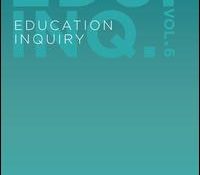eric.ed.gov har udgivet: Six years after passage of No Child Left Behind and midway to the nation’s goal of having students on grade level or better in reading and math by 2014, more data than ever before has been collected about the academic performance of American students and schools. Information in this brochure charts student demographics, achievement-to-date and trends for Florida as a state and as compared to national statistics. Information on graduation rates, tutoring/choice programs and flexibility options is also included. Link til kilde
Like this:
Like Loading...
eric.ed.gov har udgivet: Six years after passage of No Child Left Behind and midway to the nation’s goal of having students on grade level or better in reading and math by 2014, more data than ever before has been collected about the academic performance of American students and schools. Information in this brochure charts student demographics, achievement-to-date and trends for Maine as a state and as compared to national statistics. Information on graduation rates, tutoring/choice programs and flexibility options is also included. Link til kilde
Like this:
Like Loading...
eric.ed.gov har udgivet: Six years after passage of No Child Left Behind and midway to the nation’s goal of having students on grade level or better in reading and math by 2014, more data than ever before has been collected about the academic performance of American students and schools. Information in this brochure charts student demographics, achievement-to-date and trends for Maryland as a state and as compared to national statistics. Information on graduation rates, tutoring/choice programs and flexibility options is also included. Link til kilde
Like this:
Like Loading...
eric.ed.gov har udgivet: Six years after passage of No Child Left Behind and midway to the nation’s goal of having students on grade level or better in reading and math by 2014, more data than ever before has been collected about the academic performance of American students and schools. Information in this brochure charts student demographics, achievement-to-date and trends for Kentucky as a state and as compared to national statistics. Information on graduation rates, tutoring/choice programs and flexibility options is also included. Link til kilde
Like this:
Like Loading...
eric.ed.gov har udgivet: Six years after passage of No Child Left Behind and midway to the nation’s goal of having students on grade level or better in reading and math by 2014, more data than ever before has been collected about the academic performance of American students and schools. Information in this brochure charts student demographics, achievement-to-date and trends for Delaware as a state and as compared to national statistics. Information on graduation rates, tutoring/choice programs and flexibility options is also included. Link til kilde
Like this:
Like Loading...
eric.ed.gov har udgivet: Six years after passage of No Child Left Behind and midway to the nation’s goal of having students on grade level or better in reading and math by 2014, more data than ever before has been collected about the academic performance of American students and schools. Information in this brochure charts student demographics, achievement-to-date and trends for Mississippi as a state and as compared to national statistics. Information on graduation rates, tutoring/choice programs and flexibility options is also included. Link til kilde
Like this:
Like Loading...
eric.ed.gov har udgivet: This study seeks to answer the following question: Are impacts on Head Start classroom quality associated with impacts of Head Start on children’s learning and development? This study employs a variety of descriptive and quasi-experimental methods to explore the role of classroom quality as a mediator or mechanism of Head Start impacts. This research uses data from the Head Start Impact Study (HSIS) and includes 4,440 3- and 4-year-old children who were randomly assigned off a waitlist to either receive an invitation to participate in Head Start services or to the control group. Children initially applied to 351 Head Start programs across 81 Head Start grantees. A total of 2,644 children were randomized to receive Head Start services and 1,796 were randomized to the control group. Following… Continue Reading →
Like this:
Like Loading...
tandfonline.com har udgivet en rapport under søgningen “Teacher Education Mathematics”: ABSTRACT ABSTRACT This study describes and critically discusses a development project designed to create and enact a local language policy at a Swedish multilingual school, its context, content and implementation dimensions. The collaborative construction of a school language policy is a complex process, with tensions that need to be resolved. By describing the processes involved in the language policy project we examine the factors that facilitated and obstructed the enactment of the language policy. The data include 25 interviews with school headteachers and staff members, 15 observations of teachers and school-age educare teachers, field notes, and audio recordings of research circles. Drawing on insights from the enactment framework, the analysis reveals three important themes with respect to the enactment processes:… Continue Reading →
Like this:
Like Loading...
eric.ed.gov har udgivet: This reports presents interview findings with education policymakers on various aspects of educational research. The sampling contained the following groups: superintendents and other local education officials; chief state school officers; state higher education executive officers; state legislators; governors’ educational policy advisors; congressional staff members; and education association executive directors. Altogether, 142 interviews were conducted. The interviews covered the following aspects of educational research: (1) research priority areas from policymakers’ perspectives; (2) access to and use of existing research; (3) assessment of existing research; and (4) suggestions for improving education research. Student achievement–especially achievement in reading, math, and science–and its relationship to effective instruction, curricula, programs, and policies was the highest priority for research shared by the policymakers interviewed across groups. Respondents also expressed the importance of research… Continue Reading →
Like this:
Like Loading...
tandfonline.com har udgivet en rapport under søgningen “Teacher Education Mathematics”: Professor Arthur Philip Cracknell FRSE 1940-2021 Link til kilde
Like this:
Like Loading...

